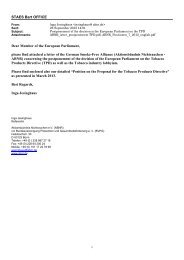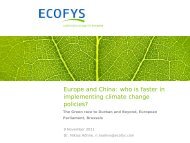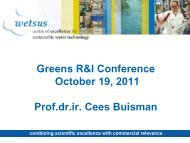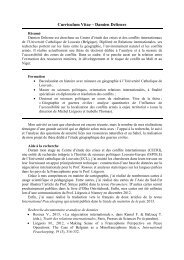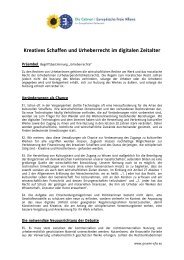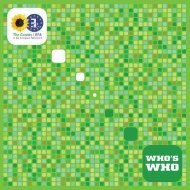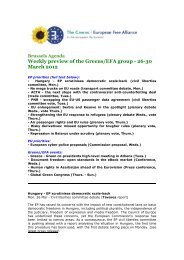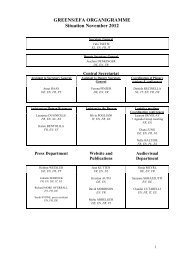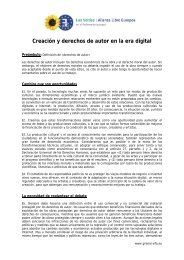Agro-Biotechnology: - The Greens | European Free Alliance
Agro-Biotechnology: - The Greens | European Free Alliance
Agro-Biotechnology: - The Greens | European Free Alliance
You also want an ePaper? Increase the reach of your titles
YUMPU automatically turns print PDFs into web optimized ePapers that Google loves.
Cloning in farm animals potential benefits, products and players | Cloned farm animals - a ‚killing application‘? | 25<br />
New Zealand. EFSA estimates that the total number of clones alive world-wide<br />
in 2007 was less than 4000 cattle and 500 pigs.” (EFSA 2008a).<br />
Until 2010 there were still no peer reviewed publications available based on<br />
empirical systematic research. For example, Heiner Niemann, who works for a<br />
governmental research institute in Germany 25 and was involved in the EFSA<br />
opinion in 2008 and 2009, told Testbiotech by direct communication that so<br />
far about 4000 cloned cattle and around 1000-1500 pigs had been born. He<br />
said that this was just an estimation but upon request he could not present<br />
any peer reviewed publications. In addition he mentioned the EFSA and FDA<br />
as relevant sources, but neither of these institutions cite sufficiently reliable<br />
sources. This means that the actual number of cloned farm animals meant for<br />
food production cannot be precisely determined.<br />
<strong>The</strong> news agency Reuters reported in 2009 that there were around 600 cloned<br />
cattle in Japan 26 . Adding the 120 cloned cattle in Europe and 600 in the US it<br />
is hard to believe that the number of 4000 cloned cattle as quoted is actually<br />
correct. Moreover substantial numbers of cloned pigs and cattle are meant for<br />
medical purposes (see Schnieke, 2009).<br />
<strong>The</strong>re might be some vested interests in cultivating the impression that many<br />
more cloned animals for food production have already been produced than is<br />
actually the case. This might put pressure on EU authorities to allow market<br />
authorisation. For example, ViaGen told Reuters in 2009 that 6000 cloned cattle<br />
already existed in the US 27 - just one more figure that cannot be verified since<br />
no registration is available. <strong>The</strong>re is also some confusion about which cloning<br />
technologies (SCNT or ECNT or Embryo Splitting) are taken into account. Yang<br />
et al., (2007), for example, reported that in the US about 2000 bulls had been<br />
derived from embryo splitting.<br />
Compared to the relatively low number of animals, the propagation and dissemination<br />
of the genetic material throughout the populations via artificial<br />
insemination (using semen from cloned bulls) is much more relevant. This is<br />
also explained by FDA, 2008:<br />
“SCNT has the potential to impact animal breeding in as fundamental a<br />
manner as artificial insemination. Given its current high costs (approximately<br />
$20,000 for a live calf) and relatively low success rates (< 10 percent), SCNT<br />
will likely be used to improve production characteristics of food producing<br />
animals by providing breeding animals, just as any breeding program would<br />
select the most elite animals for breeding, and not as production animals.”<br />
25 Friedrich Loeffler Institute, Institute of Animal Genetics, belonging to Federal Ministry of Food,<br />
Agriculture and Consumer Protection, BMELV<br />
26 http://www.reuters.com/article/idUSTRE50J1SV20090120<br />
27 http://www.reuters.com/article/idUSN127887120091113?loomia_ow=t0:s0:a49:g43:r1:c1.000000:b3<br />
0344402:z0



